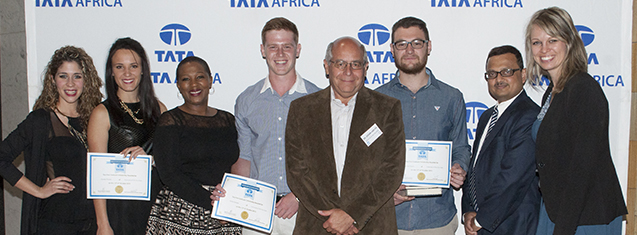
The top three individual bursary winners with TATA and UFS representatives. From Left: Naquita Fernandes, Henrike Prinsloo, Lebohang Motsisi, Stefan Strampe, Dr. Johan van Zyl, Jehan van Vuuren, Sanjeeb Lahiri and Salomien Boshoff.
Photo: Lize Van Den Berg
Learning from industry experts is essential for students’ development. When that learning eases the financial burden of tuition fees, it is even better. TATA Africa has ensured that students from the University of the Free State (UFS) earn academic currency for displaying leadership and business skills.
Jehan Van Vuuren walked away with R40 000 in his student account, Hendrike Prinsloo earned herself R30 000, Stephan Strampe has R25 000 less to worry about when the 2016 academic year arrives, and seven other students managed to save their parents R20 000 each.
These top 10 Strategic Marketing students from the UFS Department of Business Management and Department of Communication Science took up the challenge of devising strategic concepts to be implemented by the Africa branch of TATA Group companies.
TATA Group is a multinational conglomerate which specialises in a wide range of products and services, such as automobile manufacturing, hotel accommodation, construction, textiles, food and beverages, amongst other enterprises operating under its banner. On 15 October 2015, the company’s Head Office representatives signed a cheque for R275 000 to reward the creative input of our students.
Lesle-Ann George won an academic bursary worth R20 000 for her individual effort, and was also part of one of the best four groups that won R10 000 each. She said the competition was an opportunity of a lifetime. The financial aid will be channeled towards the BCom Marketing Honours degree she intends pursuing next year.
The students’ ideas included market research for TATA motors, the development of a mobile application for the Taj Hotel, as well as innovative student-oriented social media, and guerrilla marketing strategies.
“This collaborative partnership between TATA Africa and UFS has provided the students with an opportunity to learn from key role-players in the industry and, in turn, to gain practical exposure to real-life industry happenings,” said Naquita Fernandes, a Business Management lecturer and the competition’s co-organiser.